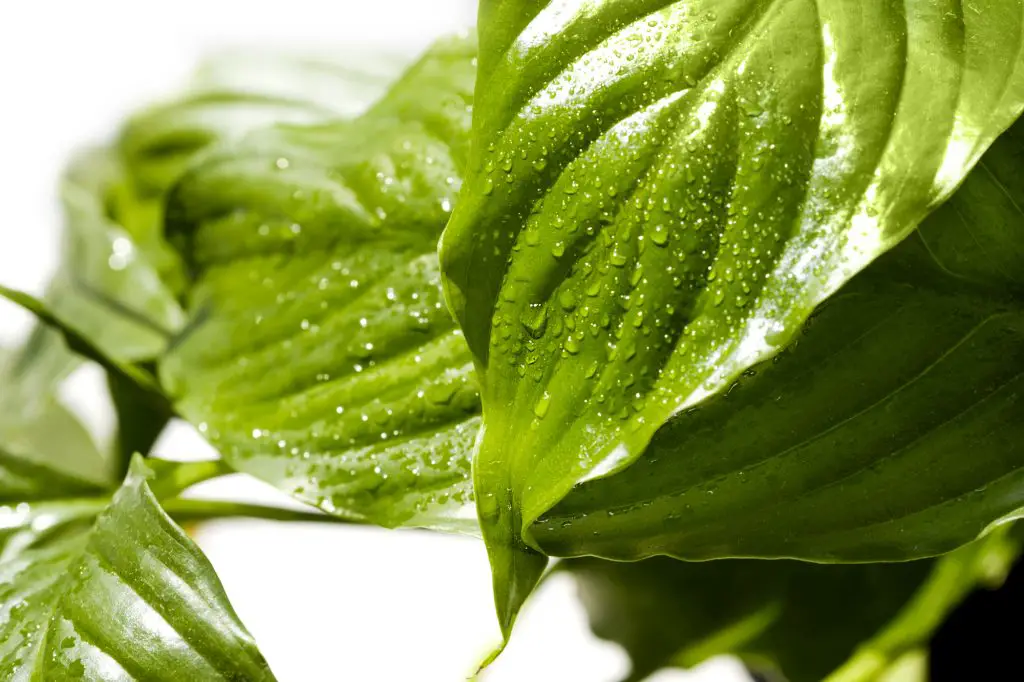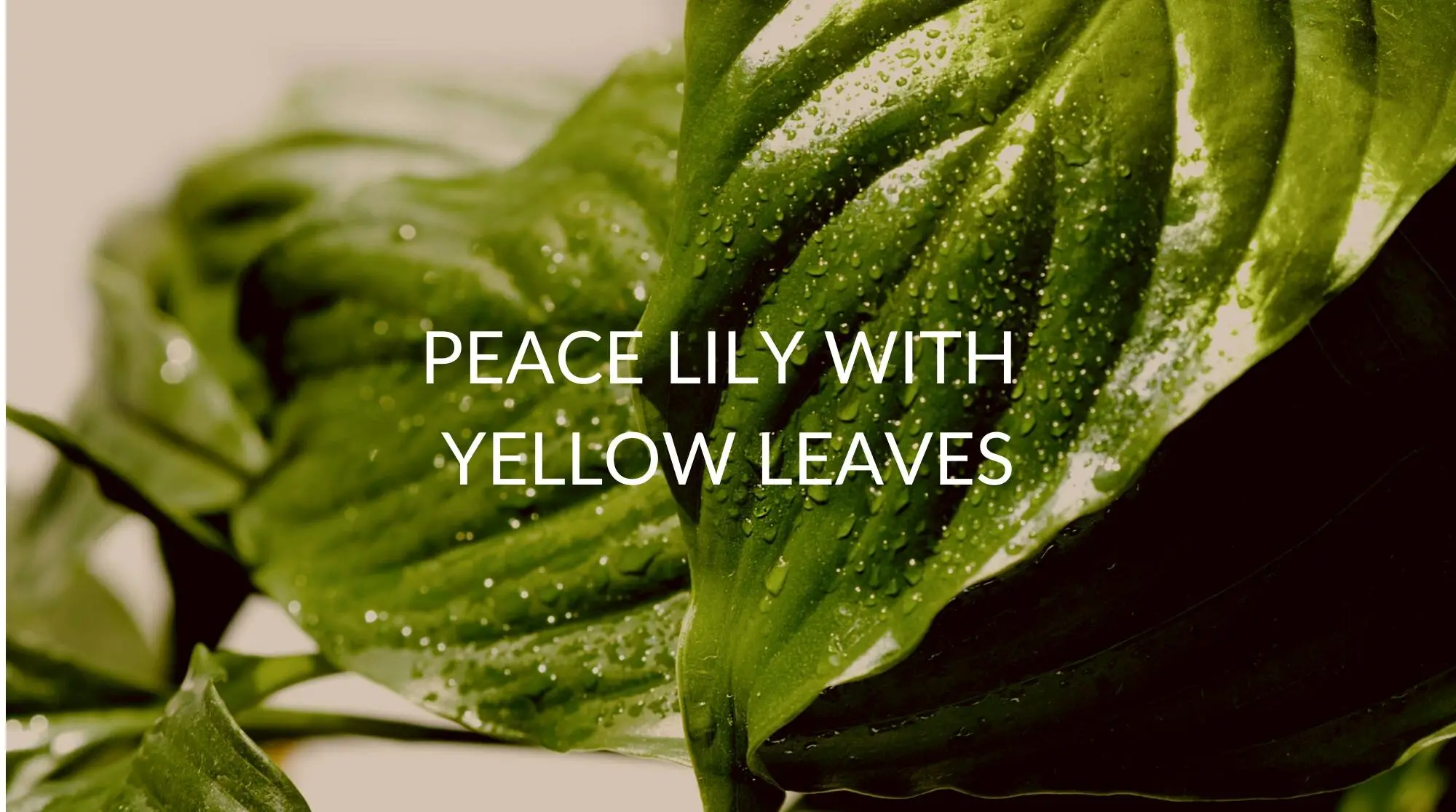Peace Lilies have always been great starter indoor plants for those who want to begin their plant care journey, and this is for a good reason. They are easy to maintain and require very minimal care from their owners.
However, this doesn’t mean that they are immune from plant issues. Sometimes, you may notice that your Peace lily starts developing yellow leaves and wonder what causes it. So, in this article, keep on reading to know the reason behind your Peace Lily’s leaves are turning yellow and what you can do about it.
Why are my Peace Lily Leaves Turning Yellow?
Overwatering
The first and most common reason your Peace Lilies turn yellow is too much water or moisture in the soil. When you give your plant too much water or when your pot lacks a good drainage system, the soil is at risk of getting too soggy, and your Peace lily’s roots get suffocated. When this happens, they would not be able to absorb the right amount of oxygen, nutrients, and minerals for your plant. This can eventually result in a bad case of root rot.
When root rot sets in, the roots will decay, affecting the whole plant from the base to the top. The signs begin to appear. A foul smell can develop from your plant’s roots as they start to decay. These symptoms can also be seen on the leaves because they will turn yellowish.
Underwatering
Peace lilies are not constantly thirsty plants, but this doesn’t mean that they don’t need enough water to survive. In fact, underwatering is another reason why your Peace Lilies’ leaves can start to turn yellow. When your plants don’t get the adequate amount of water they need, it can damage them.

Natural Aging
Peace Lilies are one of the well-known perennial plants, which means they are highly capable of living over a long period of time. However, this doesn’t mean that their leaves will stay green forever. Just like any other plant, Peace Lilies’ leaves turn yellow as they grow older over time.
This discoloration starts from the bottom leaves as they’re the first ones to wither. If natural aging is the cause of your Peace lily’s leaves becoming yellow, it’s not really a cause of concern. Aside from the discoloration of these leaves, you may also see them drying up and falling off as a part of your plants’ aging process.
Too Much or Too Little Light
Lighting can also be a factor when it comes to why your Peace Lilies’ leaves turn yellowish. Although Peace Lilies are low-light plants, they still need proper lighting to thrive. When they get too little or too little light, the effect can be seen on the leaves. Too much sunlight can result in sunburn or leaf scorch, but too little of it can also cause them to become pale.
Climate & Temperature Issues
Peace Lilies do well in temperatures around 68-85 degrees Fahrenheit or 20-30 degrees Celsius. These plants thrive in areas with USDA hardiness zones of 11 and 12. They enjoy a warm but not extreme climate, as they are originally found on forest floors within the tropical rainforests of South America. If you live in places where it gets too hot or cold, it can also be a culprit for yellowish leaves.
Nutrient Deficiencies
Nutrient deficiency is one of the most common issues in plants, and Peace Lilies can also be affected by this. Many Peace Lily owners decide not to give fertilizers to their plants, and the truth is, they can survive even without them. However, when your Peace Lily is not getting enough necessary nutrients and minerals like Nitrogen, Iron, and Magnesium, this can cause yellowed leaves while the veins remain green. This condition is called chlorosis.
Pest Infestation
Compared to other indoor plants, Peace Lilies can be quite immune to pests and insects as they do not attract them that much. However, this doesn’t mean that they are completely safe from pest infestations. When your Peace Lily gets too much or too little water, bugs might infest them.
Every once in a while, you may see spider mites, aphids, or mealybugs feeding off your plant. If you check your Peace Lily’s foliage turning yellow and getting dry, it is most likely infested by mealy bugs.
Fungal Infections
When your Peace Lily gets infected by different fungus diseases such as Phytophthora parasitica and Cylindrocladium Spathiphyllum, they begin developing yellow and brown foliage. These types of fungi can be found in your soil and are usually caused by overwatering and too much moisture.
Once you see these symptoms appearing, the sad news is, it’s too late for your plant to survive. Fungal infections are usually fatal, and it’s best to throw away your infected plant to avoid spreading it to your other plants. After all, prevention is always better than cure.
Transplant Shock
Repotting is an essential part of Peace Lily care. It is vital to ensure that your Peace Lily thrives for a long period of time and to encourage blooming. But when done incorrectly, transplanting your plant can cause some shock to its system. It takes time for your Peace Lily to adapt to its new growing soil, and you may see your plant showing signs of drooping, wilting, or yellowing leaves. There could be many reasons for this: Your Peace Lily’s new soil, new environment, and even the weather when you did the repotting are all factors contributing to the shock.
When your Peace Lily suffers from transplant shock, there’s no need to panic. It takes a week or two for your plant to adjust to its new home.
Water Quality Issues
If you live in areas where the water quality is heavily reliant on chlorine and full of minerals, using tap water for your Peace lilies can also affect their leaves’ color. Peace Lilies, just like most indoor plants, don’t do well with chlorinated water and usually lead to yellow or brown leaves. This can also cause deterioration to your plant’s health, so it’s not a good idea to use for your Peace Lily.
If possible, use rainwater, distilled, or filtered water for your plant. If you will use tap water, let the water sit for a day or two, dechlorinating it before using it to your Peace Lily.
How to Treat Peace Lily With Yellow Leaves
From all the possible causes mentioned above, knowing the reason behind your Peace Lily’s yellowing leaves is quite a challenge. Nevertheless, not all hope is lost for your Peace, Lily. Here are the things you can do to treat your Peace Lily’s Yellow leaves, or even better, prevent them.
Aging
When Peace lilies reach old age, it is natural for their leaves to turn yellow, dry up and eventually fall off. There’s nothing you can do to stop this unless you have the power to turn back the time. If your leaves’ pale color is mainly due to aging, you can simply leave it be, or prune them away to make way for new leaves to sprout.
Watering Tips
Since overwatering is the most common reason behind yellowing Peace Lily leaves, it is crucial to know the proper way of watering your plant. The first thing to consider is the schedule. Some owners prefer to water their Peace Lily every week; some do it every two, depending on several factors like the season, humidity, and temperature.
But instead of simply guessing when you should give water to your Peace Lily, check your pot. If one-third of your soil has already dried up, you better get moving and start watering. Also, ensure that your plant pot has proper drainage to avoid getting your soil waterlogged.
The proper way of watering your Peace Lily not only prevents yellowing leaves. It also prevents a severe case of untreatable fungal infection.
Lighting
Although Peace lilies are considered low light plants, this doesn’t mean they don’t need sunlight at all!
Peace Lilies still need the right amount of lighting to survive. They require bright indirect sunlight to be in their best health. So, consider placing your plant under a shade where it can still receive some bright dappled sun rays to avoid leaf scorch. A good source of light helps your Peace Lily not just to maintain its green leaves but also to reach its optimum health.
Climate and Temperature
Temperature changes directly affect your Peace Lilies, both negatively and positively. To prevent yellowing leaves due to climate and temperature, keep your plant away from areas with extreme weather systems. This is absolutely important if you live in areas with scorching summers and frosty winters; it’s best to keep them indoors where the temperature is milder and more controlled.
Fertilization
Peace lilies don’t require much fertilization. In fact, feeding your Peace Lily with too much fertilizer can do more harm than good to them. But if you plan to fertilize your plant, make sure to use water-soluble ones that are designed for Peace Lilies monthly during its growth period.
On the other hand, using a high-quality potting mix for your plant is more than enough to ensure that it’s getting the nutrient that it needs.
Pest Infestation
When your Peace Lily is overwatered or underwatered, it is more likely for it to become infested with common pests and develop illnesses. Washing your plant usually fixes the infestation, but a more severe case requires proper treatment using insecticides. Still, the best way to prevent your Peace Lily from being infested with pests is to keep it clean and well-maintained.
Conclusion
When your Peace Lily starts developing Yellow leaves, the first thing you can do is diagnose the real reason behind it. Doing this can help you properly assess your plant’s condition and move on to finding the right solution. From what we have learned today, having yellow leaves on your Peace Lily can either be a symptom of its underlying health issue or simply caused by natural factors. Whatever the cause is, remember that there’s no reason to panic. Instead, simply trim your yellowed leaves from your plant using sterile pruning scissors as they will not go back to being green again.
But of course, the best course of action would be to prevent it from happening in the first place. By following the useful tips we discussed today, you can make sure that your Peace lily stays vibrant, healthy, and happy!

